2009 AUDI TT COUPE ECU
[x] Cancel search: ECUPage 131 of 316

- Make sure that your safety be lt s ar e alw ay s re ady fo r use
a nd are not damaged.
& WARNING
Not wearing safety belts or wearing them improperly increases
the risk of ser ious personal injury and death . Safety belts can work
only when used correctly.
• Always fasten your safety belts correctly before driving off and
make sure all passengers are properly restrained .
• For maximum protection , safety belts must always be posi
tioned correctly on the body.
• Never strap more than one person , including small children ,
into any single safety belt .
• Never place a safety belt over a child sitting on your lap.
• Always keep feet in the footwell in front of the seat while the
vehicle is being driven.
• Never let any person ride with feet on the instrument panel or
sticking out the window or on the seat.
• Never remove a safety belt while the vehicle is moving. Doing
so will increase your risk of being injured or killed.
• Never wear belts twisted.
• Never wear belts over rigid or breakable objects in or on your
clothing, such as eye glasses, pens, keys , etc ., as these may cause
injury .
• Never wear the shoulder part of the belt under your arm or
otherwise out of position .
• Several layers of heavy clothing may interfere with correct posi
tioning of belts and redu ce their effectiveness .
• Always keep belt buckles free of anything that may prevent the
bu ckle from latching securely .
• Never use comfort clips or devices that create slack in the
shoulder belt . However , special clips may be required for the
correct use of some child restraint systems.
Safety first
Safety belts
& WARNING !continued)
• Never allow safety belts to become damaged by being caught
in door or seat hardware.
• Torn or frayed safety belts can tear and damaged belt hardware
can break in an accident . Inspect belts regularly . If webbing , bind
ings, buckles, or retractors are damaged, have belts replaced by an
authori zed Audi dealer or qualified workshop.
• Safety belts that have been worn and loaded in an accident
must be replaced with the correct replacement safety belt by an
authorized Audi dealer or qualified workshop . Replacement may
be necessary even if damage cannot be clearly seen. Anchorages
that were loaded must also be inspected .
• Never remove , modify , disassemble, or try to repair the safety
belts yourself .
• Always keep the belts clean. Dirty belts may not work properly
and can impair the function of the inertia reel
=> page 209 , "Safety
belts" .•
Safety belts
Fastening safety belts
S eat firs t - everybo dy b uckle u p!
Vehicle care I I
Fig . 106 Belt buckle
and tongue on the
driver 's seat
Iii>-
irechnical data
Page 132 of 316

___ S_a_ f_ e_ t-= y_ b_e_ l_ t _s _______________________________________________ _
To provide maximum protection, safety belts must always
be positioned correctly on the wearer's body.
Adjust the front seat and head restraint properly
=> page 69, "General recommendations ".
Hold the belt by the tongue and pull it evenly across the
chest and pelvis=>&.
- Insert the tongue into the correct buckle of your seat
until you hear it latch securely => page
129, fig. 106.
Pull on the belt to make sure that it is securely latched in
the buckle.
Automatic safety belt retractors
Every safety belt is equipped with an automatic belt retractor on the
shoulder belt. This feature locks the belt when the belt is pulled out
fast, during hard braking and in an accident . The belt may also lock
when you drive up or down a steep hill or through a sharp curve.
During normal driving the belt lets you move freely.
Safety belt pretensioners
The safety belts on the front seats are equipped with a belt preten
sion er that helps to tighten the safety belt and remove slack when
the pretensioner is activated. The function of the pretensioner is
monitored by a warning light:::::,
page 78, "Airbag system
t!A (USA models) /!.ir (Canada models)".
Switchable locking feature
Every safety belt except the one on the driver seat is equipped with
a switchable locking feature that
must be used when the safety belt
is used to attach a child seat. Be sure to read the important informa
tion about this feature:::::,
page 168.
& WARNING
Improperly positioned safety belts can cause serious injury in an
accident :::::,
page 130, "Safety belt position".
• Safety belts offer optimum protection only when the seat back
is upright and belts are properly positioned on the body.
• Never attach the safety belt to the buckle for another seat.
Attaching the belt to the wrong buckle will reduce safety belt
effectiveness and can cause serious personal injury.
• A passenger who is not properly restrained can be seriously
injured by the safety belt itself when it moves from the stronger
parts of the body into critical areas like the abdomen.
• Always lock the convertible locking retractor when you are
securing a child seat in the vehicle:::::,
page 170. •
Safety belt position
Correct belt position is the key to getting maximum
protection f ram safety belts.
Fig. 107 Head restraint
and safety belt posi
tion as seen from the
side
Use the height adjustment to change the position of the shoulder
straps of the front seat safety belts.
~
Page 133 of 316
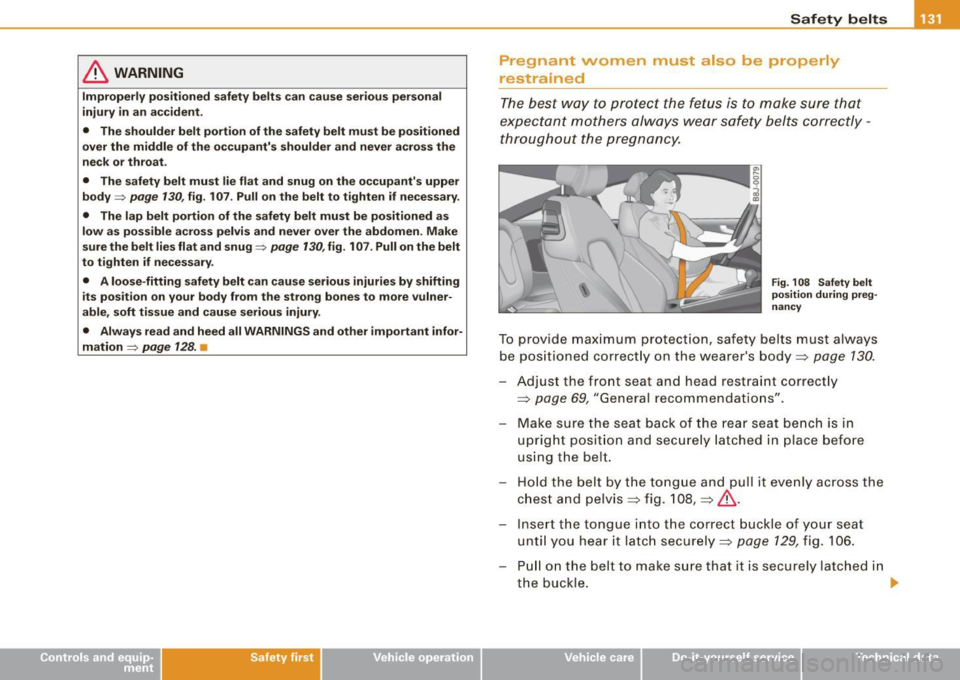
& WARNING
Improperly positioned safety belts can cause serious personal
injury in an accident.
• The shoulder belt portion of the safety belt must be positioned
over the middle of the occupant's shoulder and never across the
neck or throat .
• The safety belt must lie flat and snug on the occupant's upper
body =>
page 130, fig. 107 . Pull on the belt to tighten if necessary .
• The lap belt portion of the safety belt must be positioned as
low as possible across pelvis and never over the abdomen. Make
sure the belt lies flat and snug=>
page 130, fig. 107. Pull on the belt
to tighten if necessary.
• A loose -fitting safety belt can cause serious injuries by shifting
its position on your body from the strong bones to more vulner
able, soft tissue and cause serious injury.
• Always read and heed all WARNINGS and other important infor
mation=>
page 128. •
Safety first
Safety belts
Pregnant women must also be properly
restrained
The best way to protect the fetus is to make sure that
expectant mothers always wear safety belts correctly -
throughout the pregnancy.
Fig. 108 Safety belt
position during preg
nancy
To prov ide maximum protection, safety belts must always
be posi tioned correctly on the wearer's body~
page 130.
-Adjust the front seat and head restraint correctly
~ page 69, "General recommendations".
- Make sure the seat back of the rear seat bench is in
upright position and securely latched in place before
using the belt.
- Hold the belt by the tongue and pull it evenly across the
chest and pelvis => fig. 108 ,
~ &.
- Insert the tongue into the correct buckle of your seat
until you hear it latch securely ~
page 129, fig. 106.
- Pull on the belt to make sure that it is securely latched in
the buckle. •
Vehicle care I I irechnical data
Page 169 of 316
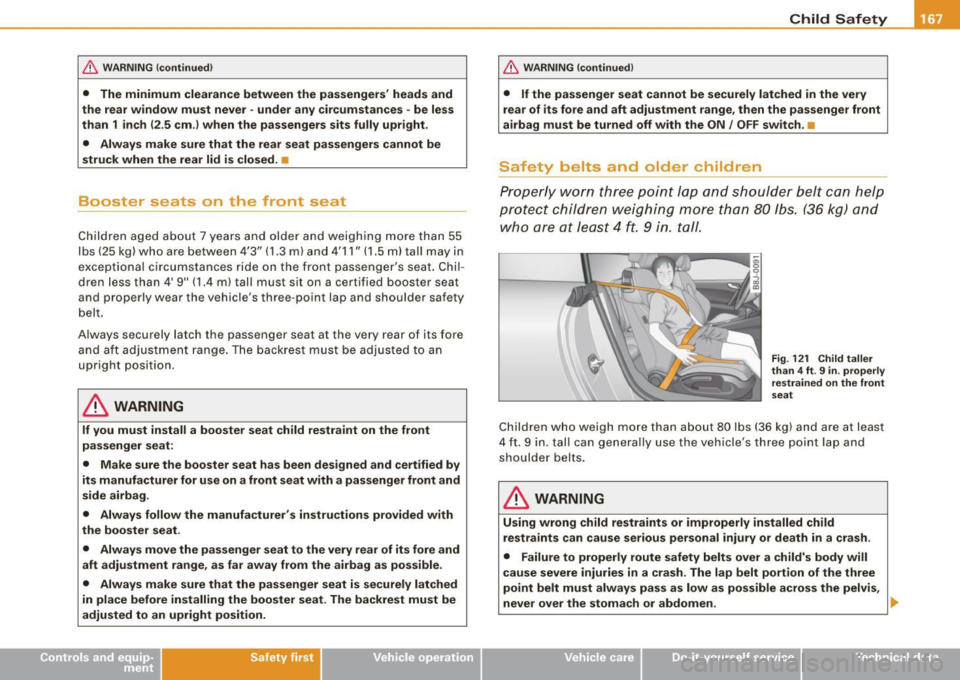
& WARNING !continued )
• The minimum clearance between the passengers ' heads and
the rear window must never -under any circumstances -be less
than
1 inch ( 2 .5 cm .) when the passengers sits fully upright.
• Always make sure that the rear seat passengers cannot be
struck when the rear lid is closed. •
Booster seats on the front seat
Children aged ab out 7 yea rs and older an d weig hing more than 55
lbs 125 kg) who are between 4'3" (1.3 m) and 4'11" (1.5 m ) ta ll may in
e xceptional c ircumstances ride on the fr ont pas senge r's sea t. Chil
d ren l ess t han
4' 9" 1 1.4 m) tall must sit on a certified boos te r seat
and properly wear the vehicle's three -p o int la p and shoulder safety
belt.
A lways securely latch the passenger seat at the very rear of its fore
a nd a ft ad justment ra nge . T he b ackr est mu st b e ad juste d to an
upr ight position .
& WARNING
If you must install a booster seat child restraint on the front
passenger seat:
• Make sure the booster seat has been designed and certified by
its manufacturer for use on a front seat with a passenger front and
side airbag .
• Always follow the manufacturer's instructions provided with
the booster seat .
• Always move the passenger seat to the very rear of its fore and
aft adjustment range , as far away from the airbag as possible .
• Always make sure that the passenger seat is securely latched
in place before installing the booster seat. The backrest must be
adjusted to an upright position .
Safety first
Child Safety
& WARNING !continued )
• If the passenger seat cannot be securely latched in the very
rear of its fore and aft adjustment range, then the passenger front
airbag must be turned off with the ON / OFF sw itch .•
Safety belts and o lder children
Prope rly worn th ree point la p an d sh oul der belt can hel p
p rotect ch ild ren weighi ng mor e th an 8 0 lbs. (3 6 kg) and
w ho are at lea st 4
ft. 9 in . tall .
Fig . 121 Child taller
th an 4
ft . 9 in . properly
restrained
on the front
seat
C hil dren who weigh mor e tha n about 80 lb s (36 kg) a nd are a t lea st
4 ft. 9 in. ta ll can gene ra lly use the vehicle's three point lap and
shou lder belts .
& WARNING
Using wrong child restraints or improperly installed child
restraints can cause serious personal injury or death in a crash .
• Failure to properly route safety belts over a child's body will
cause severe injuries in a crash . The lap belt portion of the three
point belt must always pass as low as possible across the pelvis ,
never over the stomach or abdomen .
~
Vehicle care I I irechnical data
Page 170 of 316
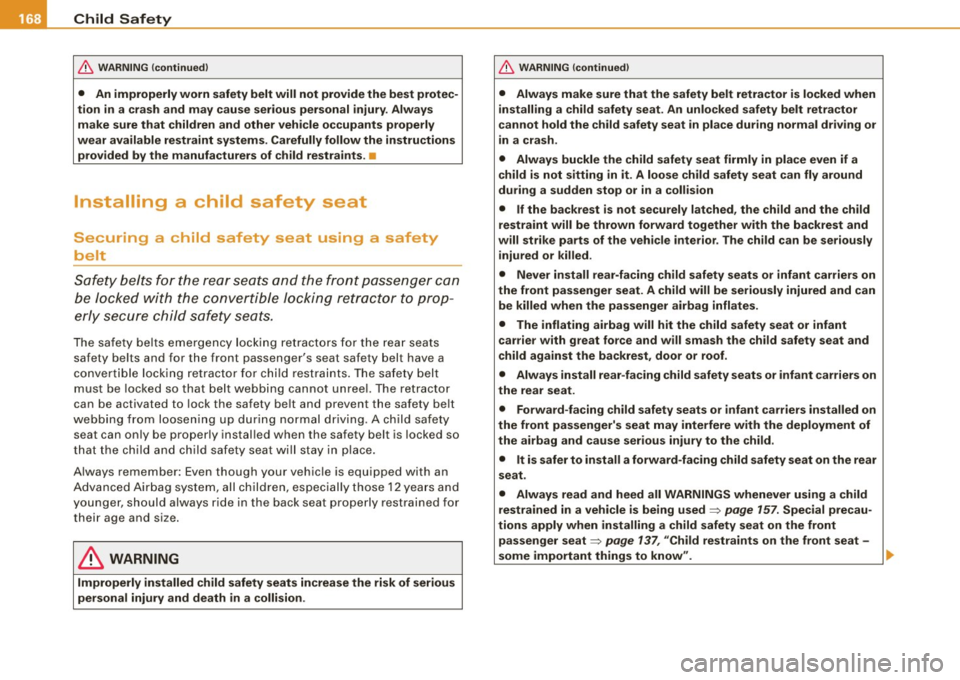
___ C_h_ i_ ld _ S_ a_ f_ e_ t_y ____________________________________________ _
& WARNING (continued )
• An improperly worn safety belt will not provide the best protec
tion in a crash and may cause serious personal injury . Always
m ake sure that children and other veh icle occupants properly
wear available restraint sy stem s. Carefully follow the instructions
provided by the manufacturers of child restraints . •
Installing a child safety seat
Securing a child safety seat using a safety
belt
S afety belts f or the rear sea ts an d the front pa ssenger can
b e l ocke d wit h th e co nv erti ble lockin g ret racto r to p rop
erly secu re c hild safety sea ts.
The safe ty be lts eme rgency loc king re tr acto rs for th e rea r s eat s
saf ety belts an d for t he front pass enger's seat safety be lt have a
co nve rtible lock ing retracto r for c hild r estra int s. The sa fet y b elt
must be loc ked so t hat belt we bbing cannot u nre el. T he r etrac to r
can be activated to lock the safety be lt and prevent the safety be lt
w eb bing fr om l oos enin g up dur ing n ormal dr ivi ng . A ch ild safe ty
seat can only be properly instal led when the safety belt is locked so
th at the chi ld and chi ld sa fety seat will st ay in pla ce.
Al ways rem embe r: Even t hough you r vehic le is equ ipped with an
A dva nced Airb ag s ystem, a ll chil dre n, esp ecia lly th ose 12 yea rs and
youn ger, s hou ld always ri de in the back seat prop erly rest rained for
thei r age and size .
& WARNING
Improperly installed child safety seats increase the risk of serious
personal injury and death in a collision .
& WARNING (continued)
• Always make sure that the safety belt retractor is locked when
installing a child safety seat . An unlocked safety belt retractor
cannot hold the child safety seat in place during normal driving or
in a crash.
• Always buckle the child safety seat firmly in place even if a
child is not sitting in it . A loose child safety seat can fly around
during a sudden stop or in a collision
• If the backrest is not securely latched, the child and the child
restraint will be thrown forward together with the backrest and
will strike parts of the vehicle interior . The child can be seriously
injured or killed .
• Never install rear-facing child safety seats or infant carriers on
the front passenger seat . A child will be seriously injured and can
be killed when the passenger airbag inflates .
• The inflating airbag will hit the child safety seat or infant
carrier with great force and will smash the child safety seat and child against the backrest, door or roof .
• Always install rear -facing child safety seats or infant carriers on
the rear seat.
• Forward-facing child safety seats or infant carriers installed on
the front passenger's seat may interfere with the deployment of
the airbag and cause serious injury to the child.
• It is safer to install a forward-facing child safety seat on the rear
seat .
• Always read and heed all WARNINGS whenever using a child
restrained in a vehicle is being used=> page
157 . Special precau
tions apply when installing a child safety seat on the front passenger seat=> page
137, "Child restraints on the front seat -
some important things to know" . ._
Page 172 of 316

___ C_ h_ il_ d _S_ a_fe _ ty ______________________________________________ _
Activating the convertible locking retractor
Use the convertible locking retractor to secure a child
restraint.
Always heed the child safety seat manufacturer's instruc
tions when installing a ch ild restraint in your vehicle. To
activate the convertible locking retractor:
- Place the child restraint on a seat, preferably on the rear
seat.
- Slowly pull the belt
all the way out .
-Route it around or through the child restraint belt path
=>& -
- Push the child safety seat down with your full weight to
get the safety belt really tight.
- Insert the belt tongue into the buckle for that seating
position.
- Guide the safety belt back into the retractor unt il the belt
lies flat and snug on the child safety seat .
- You should hear a "clicking" noise as the belt winds back
into the inertia reel. Test the convertible locking retractor
by pulling on the belt. You should no longer be able to
pull the belt out of the retractor. The convertible locking
retractor is now act ivated.
- Make sure that the red release button is facing away from
the child restraint so that it can be unbuckled quickly.
- Pull on the belt to make sure the safety belt is properly
tight and fastened so that the seat cannot move forward or sideways more than one inch (2 .5 cm) .
& WARNING
Using the wrong child restraint or an improperly installed child
restraint can cause serious personal injury or death in a crash.
• Always make sure that the safety belt retractor is locked when
installing a child safety seat. An unlocked safety belt retractor
cannot hold the child safety seat in place during normal driving or
in a crash.
• Always buckle the child safety seat firmly in place even if a
child is not sitting in it. A loose child safety seat can fly around
during a sudden stop or in a crash.
• Always make sure the seat backrest to which the child restraint
is installed is in an upright position and securely latched into place
and cannot fold forward. Otherwise, the seat back with the child
safety seat attached to it could fly forward in the event of an acci
dent or other emergency situation.
• Always read and heed all WARNINGS whenever using a child
restrained in a vehicle is being used=>
page 157. Special precau
tions apply when installing a child safety seat on the front
passenger seat=>
page 137, "Child restraints on the front seat -
some important things to know" .•
Deactivating the convertible locking retractor
The convertible locking retractor for child restraints will
be deactivated automatically when the belt is wound all
the way back into the retractor.
-Press the red button on the safety belt buckle. The belt
tongue will pop out of the buckle.
- Guide the belt all the way back into its stowed position .
Always let the safety belt retract completely into its stowed position.
The safety belt can now be used as an ordinary safety belt without
the convertible locking retractor for child restraints.
IJll-
Page 175 of 316
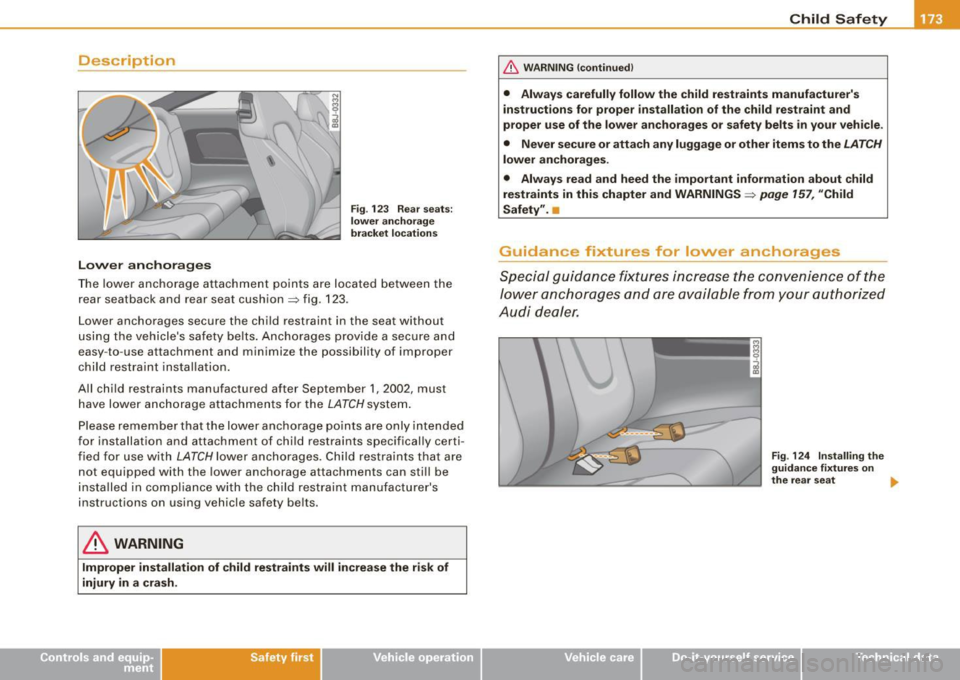
Description
Lower anchorages
Fig. 123 Rear seats:
lower anchorage
bracket locations
The lower anchorage attachment points are located between the
rear seatback and rear seat cushion~ fig. 123.
Lower anchorages secure the child restraint in the seat without
using the vehicle 's safety belts. Anchorages provide a secure and
easy -to -use attachment and minimize the possibility of improper
child restraint installation.
All child restraints manufactured after September 1, 2002, must have lower anchorage attachments for the
LATCH system.
Please remember that the lower anchorage points are only intended
for installation and attachment of child restraints specifically certi
fied for use with
LATCH lower anchorages . Child restraints that are
not equipped with the lower anchorage attachments can still be
installed in compliance with the child restraint manufacturer's
instructions on using vehicle safety belts.
,& WARNING
Improper installation of child restraints will increase the risk of
injury in a crash.
Safety first
Child Safety
& WARNING (continued)
• Always carefully follow the child restraints manufacturer's
instructions for proper installation of the child restraint and
proper use of the lower anchorages or safety belts in your vehicle.
• Never secure or attach any luggage or other items to the
LATCH
lower anchorages.
• Always read and heed the important information about child
restraints in this chapter and WARNINGS~
page 157, "Child
Safety". •
Guidance fixtures for lower anchorages
Special guidance fixtures increase the convenience of the
lower anchorages and are available from your authorized
Audi dealer.
Vehicle care I I
Fig . 124 Installing the
guidance fixtures on
the rear seat •
irechnical data
Page 176 of 316
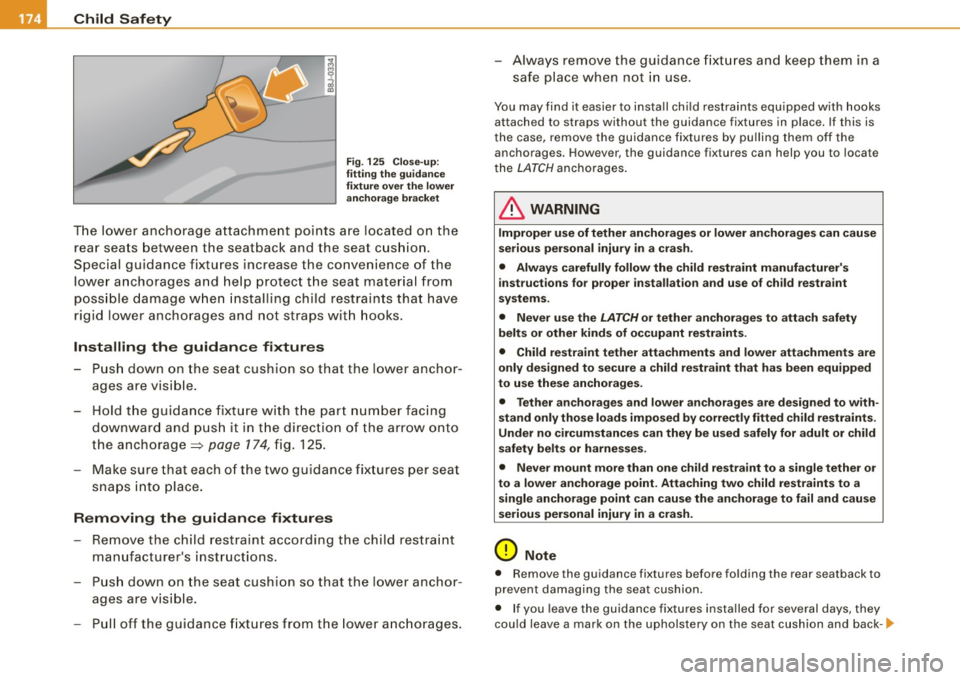
___ C_h_ i_ ld _ S_ a_ f_ e_ t_y ____________________________________________ _
Fig. 125 Close-up:
fitting the guidance
fixture over the lower
anchorage bracket
The lower anchorage attachment points are located on the
rear seats between the seatback and the seat cushion .
Special gu idance fixtures increase the convenience of the
lower anchorages and help protect the seat material from
possible damage when installing ch ild restraints that have
rigid lower anchorages and not straps with hooks.
Installing the guidance fixtures
- Push down on the seat cushion so that the lower anchor
ages are visible.
- Hold the guidance fixture with the part number facing
downward and push it in the direction of the arrow onto
the anchorage =>
page 174, fig. 125.
- Make sure that each of the two guidance fixtures per seat
snaps into place.
Removing the guidance fixtures
-Remove the child restraint according the child restraint
manufacturer's instructions.
- Push down on the seat cushion so that the lower anchor
ages are visible.
- Pull off the guidance fixtures from the lower anchorages. - Always remove
the guidance fixtures and keep them in a
safe place when not in use.
You may find it easier to install child restraints equipped with hooks
attached to straps without the guidance fixtures in plac e. If this is
the case , remove the guidance fixtures by pulling them off the
anchorages . However , the guidance fixtures can help you to locate
the
LATCH anchorages .
& WARNING
Improper use of tether anchorages or lower anchorages can cause
serious personal injury in a crash.
• Always carefully follow the child restraint manufacturer's
instructions for proper installation and use of child restraint
systems.
• Never use the
LATCH or tether anchorages to attach safety
belts or other kinds of occupant restraints.
• Child restraint tether attachments and lower attachments are
only designed to secure a child restraint that has been equipped
to use these anchorages .
• Tether anchorages and lower anchorages are designed to with
stand only those loads imposed by correctly fitted child restraints.
Under no circumstances can they be used safely for adult or child
safety belts or harnesses.
• Never mount more than one child restraint to a single tether or
to a lower anchorage point. Attaching two child restraints to a single anchorage point can cause the anchorage to fail and cause
serious personal injury in a crash.
0 Note
• Remov e the guidance fixtur es before folding th e rear se atback to
prevent damaging the seat cushion.
• If you leave the guidance fixtures installed for several days, they
could leave a mark on the upholstery on the seat cushion and back-~